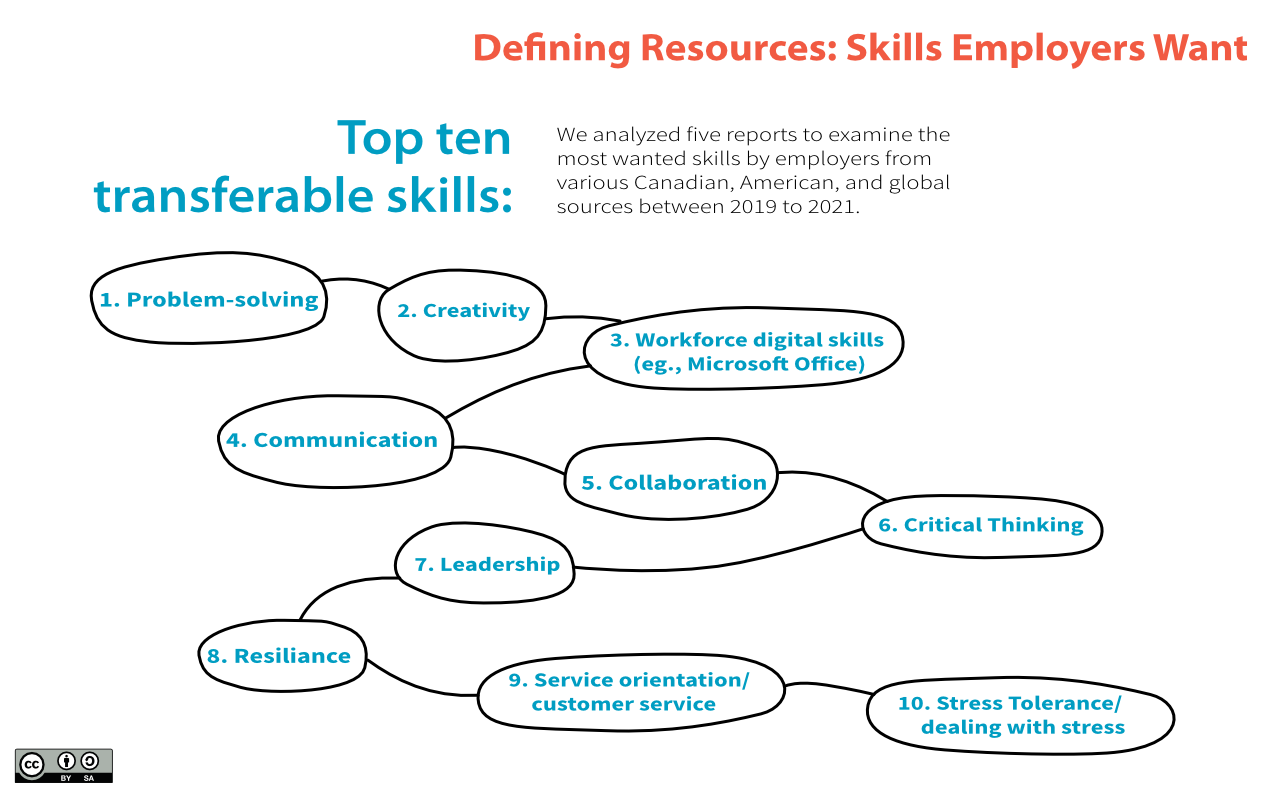Activity: Skills Employers Want
| Site: | RRU Open Educational Resources |
| Course: | Career Management Resources for Professionals |
| Book: | Activity: Skills Employers Want |
| Printed by: | Guest user |
| Date: | Wednesday, 21 May 2025, 6:51 PM |
Versatility of Transferable Skills
If you will, imagine the world of professional dance for a moment. Now think of computer programming in the world of cyber-security.
- Can you think of two professions more disparate than these?
- Can you envision a successful leap—career change—from dancer to coder?
- Can you conceptualize common transferable skills?
- Does this appear to be a far stretch?
Bryson, a Professor of Enterprise and Competitiveness, University of Birmingham proves otherwise, as he provides an example of a dancer who successfully makes a career change to political administration.
Dance as a career involves extraordinarily high levels of commitment, concentration, persistence, passion and training. Dance and cyber security are both about patterns, rhythms and attention to detail. There is nothing to suggest that dance is not a suitable pathway towards computer programming … and would be unable to compete in the world of cyber security.
Rahm Emanuel trained as a ballet dancer and eventually became senior advisor to Bill Clinton between 1993 and 1998, then chief of staff at the White House to Barack Obama and finally mayor of Chicago. (Bryson, 2020, para. 5, 7)
These examples demonstrate the versatility of transferable skills!
Develop Examples of Your Transferable Skills
Now, we invite you to review the list of transferable skills needed for the future*:

![]()
Download the Skills Employers Want Worksheet to record your answers for the following activity.
Choose one transferable skill that:
- you enjoy using,
- one you would rate yourself as “better than average” at using, and
- one that you really have not become immersed in yet.
Next, develop an example for each skill from your academic studies at Royal Roads.

Creating these examples are
for your career search—when you meet potential employers, and/or connect with your community.
Examples provide evidence. Employers want proof that you have the capability to fulfill the duties of the role. Examples detailing your abilities, skills, strengths, and knowledge within your professional applications and/or career advancement are necessary.
Stating, for example, Master of Arts in Leadership on your resume acknowledges this credential, which is a phenomenal accomplishment! However, it does not describe the transferable and technical skills that were required and/or gained to complete each course for the credential.
The examples can be brief and you can use the STARS format to construct your examples.
S/T: Situation (context)/Tasks
A: Actions you took
R: Results/outcomes
S: Skills you demonstrated
See the next page for an example of transferable skills gained from a course at Royal Roads University.
*Reference: Top 10 transferable skills:
- Problem-solving,
- Creativity,
- Workforce digital skills (e.g., Microsoft Office),
- Communication,
- Collaboration,
- Critical thinking,
- Leadership,
- Resilience,
- Service orientation/customer service,
- Stress tolerance/dealing with stress.
Workplace Learning Report 2021 - LinkedIn
Future of Skills 2019 - LinkedIn
Ahead by a Decade Employment in 2030 - Brookfield Institute for Innovation + Entrepreneurship
I, Human The Digital & Soft Skills Driving Canada's Labour Market - Brookfield Institute for Innovation + Entrepreneurship
Examples
Here is an example illustrating the MA in Leadership course with the transferable skill, collaboration.
LEAD527: Communications and Leadership in Groups and Teams
Course Description
Examines the theory and practice of leading productive teams and of facilitating groups. Fosters appreciation of students' abilities to communicate effectively in working relationships in support of productive collaboration. Develops students' expertise in promoting effective decision-making, optimizing the benefits of diversity, planning and implementing of team goals, and assessing of outcomes. Promotes awareness and application of ethical principles and concepts. Encourages a systemic perspective to ensure fluid communication with the immediate organizational environment and knowledge of influences of the environment on the team. LEAD 526, LEAD 527, and LEAD 528 are corequisites.
Course Credits
- 3.00
S/T (situation/context)/(tasks): One of the courses I completed in the Master of Arts in Leadership program was Communications and Leadership in Groups and Teams. We were required to form teams of four and develop an Equity, Diversity, and Inclusion (EDI) training package for staff at a not-for-profit organization within two weeks. I wanted to take the lead because this was my area of expertise; working in this specialization for 20+ years. However, one of my team-mates wanted to lead the project.
A (actions): I stepped down and let my team-mate lead. I observed, asked questions, offered encouragement, and redirected the team when we went off course. Also, I compiled the team’s written drafts for the project and wrote the final training document.
R (results): I learned new EDI content. Our group obtained an A on the project. The professor thought so highly of our package, she asked for our permission to share it with one of her colleagues who was an Executive Director of a not-for-profit.
S (skills demonstrated): Collaboration skills demonstrated: active listening, clear and concise communication - verbally and online through Microsoft Teams and in writing though email. Contribution to the team -
wrote the final training document.
Tip: Click exit book below to go back to the main page, or take this shortcut to move directly to the module summary.